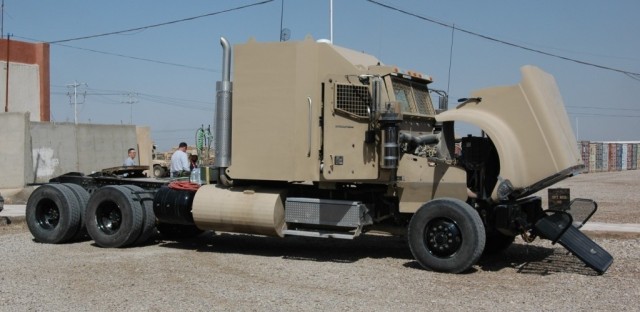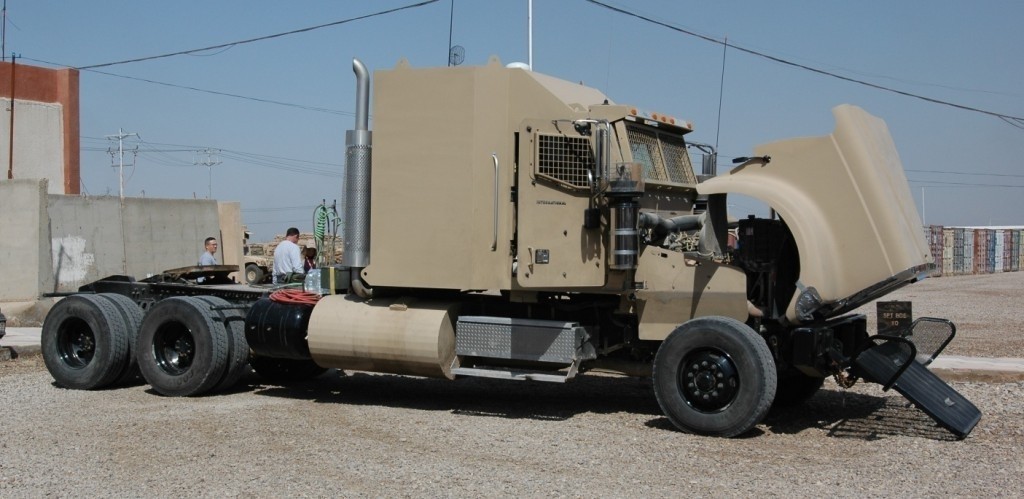
CAMP TAJI, Iraq (Army News Service, March 15, 2007) - Soldiers of the 15th Sustainment Brigade, 13th Sustainment Corps, travel the roads of Iraq nightly as part of the vital logistics train in support of all coalition forces within the Multinational Division Baghdad area.
Running the gauntlet alongside them are their civilian drivers. Contracted employees, crewing specially designed trucks, make convoy runs to support the 15th Sust. Bde.'s mission of supplying the 25,000-plus combat troops currently on the ground in the MND-B area.
Steve Mathis is no stranger when it comes to working with the military. After spending 10 years in the Army infantry, he's now the civilian convoy commander in charge of making sure the massive freight haulers get where they need to be.
"Being prior service makes it easier for us to come out here and do what we do," he said. "We understand what's going on and that helps us a great deal."
Moving everything from heavy equipment to food and water, Mathis and his partner, Mike Winters, count on the armored International 5000-MV heavy equipment transporter to pull loads in excess of 180,000 pounds - that's more than 90 tons.
"I've put a lot of stuff behind it and it hasn't bogged down yet," said Mathis. "I've taken an IED that ripped out the engine and I'm OK. I feel safe in it."
The difference between military and civilian doesn't matter outside the wire, said Mathis. The men are adamant about the fact that on the road, everyone works together as a team.
When a military vehicle rolled over during one mission, Mathis and Winters didn't even think about what needed to be done. With fuel leaking from the overturned truck, Mathis grabbed a combat lifesaver's bag and ran to help extract the Soldiers.
"Out on the main supply route, things change so quickly; you've got to be prepared to help," said Winters. He and Mathis completed the Army's combat lifesaver course.
For the 15th Sust. Bde. troops out on mission, having contractors along affords extra benefits. More trucks mean more supplies hauled, which in turn equates to fewer runs per night. Mathis and Winters also bring additional communication and global positioning systems to the convoys.
While they can't talk on military channels, their high frequency radios can reach in areas where troops have difficulties communicating. By placing hand-held radios with each of the military security vehicles, Mathis can act as a relay station to contact the contractors' dispatch hubs at either Logistics Supply Area Anaconda in Balad or Victory Base Complex in Baghdad.
By working with gun truck elements from 1060th Transportation Company or 1/115th Field Artillery, 867th Corps Support Battalion, Mathis can assist calling in help from quick reaction forces, explosive ordnance disposal teams or for medical evacuation.
"Contractors play a crucial role on the battlefield," said Col. Gregg Gross, chief of the 13th Sustainment Command Distribution Management Center. "Contractors are part of our formation. They live, eat, work, pray, sweat and sacrifice side-by-side with our Soldiers everyday. A day without contractors is like a day without food, fuel, water, ammo, clean latrines...well, suffice it to say, it's a lousy day without contractors."
Mathis and Winters have logged more than 12,000 miles since getting their new truck in 2006. The routes they take can be some of the most dangerous areas in Iraq, but they would much rather be driving outside the wire; doing what comes as second nature they said.
(Sgt. 1st Class Nicholas Conner serves with the 15th Sustainment Brigade Public Affairs Office.)

Social Sharing